One day, in 1514, a modest Polish physician and scholar named Nicolaus Copernicus dared to suggest that everyone had the wrong idea about how the universe was arranged. Most people still believed the Earth was flat and stationary, so to convince people that in fact it was spherical and in orbit around the sun, was a hard task. Tentatively, and in constant fear of ridicule and heresy, Copernicus scribbled his idea down on a bit of paper and shared it with a few close friends. Twenty years later, he was still trembling. 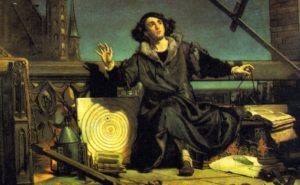 Should he publish or shouldn’t he? What would people say; what would the Church say? Copernicus was right to worry. His work was banned for years. A full century later, an Italian called Galileo Galilei, another budding scientist, took up Copernicus’ cause.
Should he publish or shouldn’t he? What would people say; what would the Church say? Copernicus was right to worry. His work was banned for years. A full century later, an Italian called Galileo Galilei, another budding scientist, took up Copernicus’ cause.
Desperate to prove Copernicus’ theory that the Earth does not stand still at the centre of the universe, but rather orbits the sun whilst rotating on its axis in the solar system, Galileo launched himself into experimentation from a young age. Once again, he hit a wall. He dared to publish, was tried by the Inquisition and tortured. 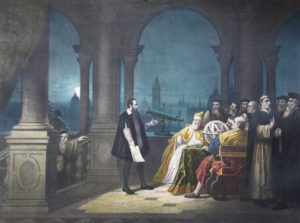 Forced to recant his theory that the Earth orbits the sun, he famously said underneath his breath, ‘…but it does move’. This did not do him much good. He was kept under house arrest for the rest of his life.
Forced to recant his theory that the Earth orbits the sun, he famously said underneath his breath, ‘…but it does move’. This did not do him much good. He was kept under house arrest for the rest of his life.
Heresy aside, the fact is, the motion of the Earth is so counter-intuitive that it is not really surprising people found it so hard to believe. Another hundred years later, Isaac Newton would silence all the critics with his publication of Principia Mathematica, bringing calculations to bear on the subject of cosmology that nobody could dispute. As they say, you cannot argue with a number. Still, there were always those that wanted to.
The Age of Enlightenment in Europe culminated in the French Revolution, but people still continued to argue about the universe. Some European scholars accepted the heliocentric view of the solar system, which placed the Earth in rotation around the sun while turning on its own axis; others did not like it. Despite the mathematics, what people really needed was a visual. Enter Léon Foucault. Like almost every other scholar of his day, Foucault studied medicine. Medicine was the first of the sciences to really take off as a discipline. Sources of experimentation were close at hand: people, cadavers, visual references. But Foucault had a handicap; he fainted at the sight of blood, which was inconvenient for a physician frequently expected to saw off limbs or draw blood with a leech. So instead he turned his attention to the nascent science of physics. 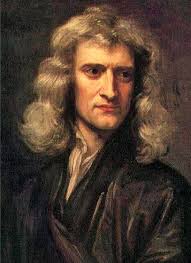 Newton had proved mathematically that all the planets in the solar system and the universe in general were in motion and that their orbits were elliptical because of the effect of gravitational attraction. But Newton himself, by then long dead, had known that mathematics would never suffice for most people because it was too abstract and too difficult to grasp. When the Principia came out, only a handful of people in the world could even hope to understand the calculations. A hundred and fifty years later, not much had changed. It would take a real revolution, even more enlightening than the French one, before the connection between mathematics and scientific theory finally began to yield palpable results. The outcome was the Industrial Revolution and by the time Foucault was a young man, it was already quite advanced.
Newton had proved mathematically that all the planets in the solar system and the universe in general were in motion and that their orbits were elliptical because of the effect of gravitational attraction. But Newton himself, by then long dead, had known that mathematics would never suffice for most people because it was too abstract and too difficult to grasp. When the Principia came out, only a handful of people in the world could even hope to understand the calculations. A hundred and fifty years later, not much had changed. It would take a real revolution, even more enlightening than the French one, before the connection between mathematics and scientific theory finally began to yield palpable results. The outcome was the Industrial Revolution and by the time Foucault was a young man, it was already quite advanced.
One day, after observing a gyroscope, Léon Foucault decided to build a giant pendulum as a way of demonstrating that the Earth is moving. A gyroscope, often used on ships for navigation, swings against a fixed point of reference. Foucault imagined placing an observer on a giant gyroscope. The result of this vision was Foucault’s Pendulum, one of many others made since, and it was housed in the Pantheon of Paris. The Foucault Pendulum experience resembles the observer on the gyroscope, apparently standing still but in reality moving in accordance with the motion of the Earth. The motion of the Earth is brought about by gravity, the attraction of one planetary body to another, and gravity, together with other natural forces such as electromagnetism, accounts for the way that matter moves. As matter is drawn in to other matter by the forces of attraction, it describes a curve. This curved path is tied in with the motion of the Earth, the swirl of a storm and even the draining of undisturbed water down a hole, although the science is too complex to explain here. 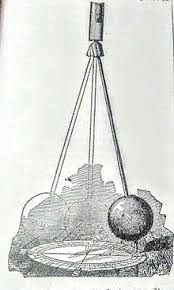 But suffice to say that the pendulum ball swings, the earth moves below it, the reference point thus changes and the ball describes a curve around the dial.
But suffice to say that the pendulum ball swings, the earth moves below it, the reference point thus changes and the ball describes a curve around the dial.
Still, people continue to remain a little mystified when they stand beside the giant ball of Foucault’s Pendulum and observe the evidence that stands against their intuition. They ask themselves, why do we move, and will it ever end? Newton did not really know the answers to these questions either, although he deeply suspected that he did and never stopped searching for them. He was responsible for declaring space a void, and he knew that thanks to the void, the world was bound by laws to keep on turning. Gravity would continue to infinity. All of which invited yet another thorny issue through the door. What exactly was infinity, and what did it signify? Read next month’s blog post to find out…
READ ABOUT BOOKS BY LUCILLE TURNER HERE

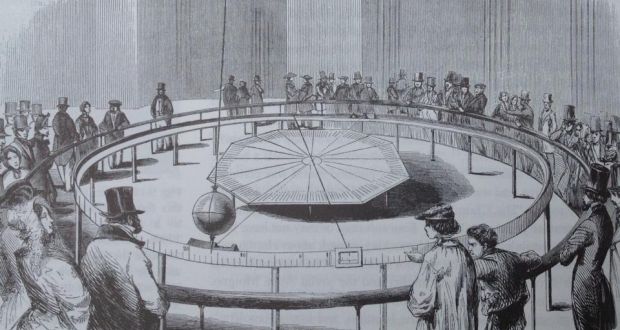

Great content! Super high-quality! Keep it up! 🙂
A big thank you for your post.Really thank you! Really Great.